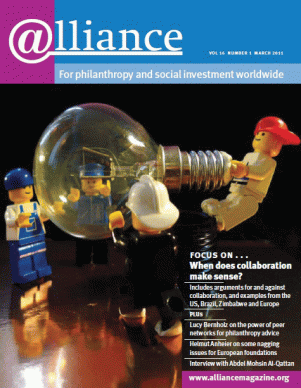As I read Lucy Bernholz’s brilliant prognosis for philanthropy and social investing for this new year, I have to confess that I was both deeply interested and positively envious. Blueprint 2011 provides an insightful and honest overview and forecast for the capital markets for social good in the US in the coming year … and it is useful knowledge!
 The report reviews a multi-billion dollar industry ($1.1 trillion in revenue in 2008). This includes philanthropic individuals, traditional grantmaking foundations, non-profits, corporations, and individuals and organizations that are exploring the investment side of philanthropy (donors, social investors, and social entrepreneurs and businesses). Blueprint 2011 not only provides a sharp overview of the position faced by the industry and a forecast of major trends for this year, but also dares compare the previous year’s forecasts with the reality of 2010. The ‘What I got wrong in Blueprint 2010’ section is really refreshing, as the focus is very much on learning from mistakes.
The report reviews a multi-billion dollar industry ($1.1 trillion in revenue in 2008). This includes philanthropic individuals, traditional grantmaking foundations, non-profits, corporations, and individuals and organizations that are exploring the investment side of philanthropy (donors, social investors, and social entrepreneurs and businesses). Blueprint 2011 not only provides a sharp overview of the position faced by the industry and a forecast of major trends for this year, but also dares compare the previous year’s forecasts with the reality of 2010. The ‘What I got wrong in Blueprint 2010’ section is really refreshing, as the focus is very much on learning from mistakes.
Blueprint’s annual edition supports continuous improvement and planning. It confronts practitioners with emerging trends (programme-related, socially responsible or impact investing, online giving, etc) and helps them navigate these new waters by calling their attention to best practices, warning them about major changes to come, and suggesting that they think out of the box for a while before returning to the hectic frontline.
I shall resist the temptation to try to summarize Blueprint’s main ideas, as a good reviewer should try to encourage readers to explore the complete 40-page report. Let me just point you towards the (very) moderately optimistic forecast for private donations, despite the Giving Pledge’s visibility and glamour; the dark prospects for public funding; the restructuring ahead in online giving markets; the emergence of new tools to track giving; and the slow but promising coming of age of social investing as the third revenue source for the social sector.
Apart from her deep knowledge of the industry, Bernholz’s thoughtful analysis builds on the rich and diverse quantitative data sources available in the US, ranging from the Foundation Center to the Johns Hopkins Center for Civil Studies and IRS-based sources such as GuideStar. As you may imagine, this is where envy comes into the picture. The first question that comes to mind is whether such a rigorous overview and forecast would be valuable and feasible in Europe. I don’t have any doubts about its potential value, since the philanthropic and social investing industry is emergent, rather than mainstream, in many European countries. A European version would undoubtedly require different categories to take account of historical and cultural differences (Blueprint’s distinction between ‘donors’ and ‘doers’ may not be useful in many European countries), but it would confirm the existence of pan-European, transatlantic and global trends for the capital markets for social good.
The only real doubt is about its feasibility. Quantitative data on philanthropy are scarce, scattered and non-systematic in Europe, as the first publication of the European Research Network on Philanthropy (ERNOP) shows. This situation is not conducive to longitudinal and regional or cross-country comparisons. As a result, researchers’ interest in these issues is limited while philanthropists and social investors not only lack useful guides of the sort provided by Blueprint 2011 but also face serious difficulties when trying to measure and explain the impact of what they do.
When I presented the newly born Institute for Strategic Analysis of Foundations (INAEF) at the annual European Foundation Centre conference in Brussels last June, I characterized the long-term goal of this research project on the Spanish philanthropic and non-profit industry as a move ‘from counting the trees to picturing the ecosystem’. Bernholz successfully manages this transition from quantitative data and descriptive narrative into qualitative and useful analysis every year. I dare predict that, during the next decade, we will see more and more European countries produce both information systems for ‘tree-counting’ and maps for the forest – in other words, measure the social capital generated by the industry and translate this into useful knowledge for decision-makers. The result will be a blueprint that helps philanthropic and social investors to face the uncertain present, better plan for the unknown future, and improve their impact on social good and economic welfare, no matter which organizational formula they choose.
Marta Rey-Garcia is associate professor of the University of A Coruña, INAEF director and ERNOP board member. Email martarey@udc.es
Philanthropy and Social Investing: Blueprint 2011
Lucy Bernholz Blueprint Research and Design $19.95
ISBN 9780615420684
To order
http://www.lulu.com





Comments (0)